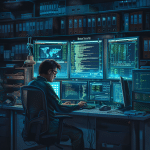Our cultural heritage is a precious treasure. It encompasses everything from ancient artifacts to contemporary art, and it’s the duty of each generation to preserve this heritage for the future. But with increasing threats of climate change, natural disasters, and even human activities, the task of preservation becomes ever more challenging. Thankfully, technology is coming to our aid, offering new and innovative ways to safeguard our shared cultural assets. Whether it’s digital archiving, restoration techniques, or the creation of virtual experiences, technology is playing a pivotal role in the preservation of art. Let’s delve deeper into this topic.
The Intersection of Art and Technology
Art and technology might seem like strange bedfellows at first. After all, the traditional artistic process often involves handcrafting, which is far removed from the cold, binary world of technology. However, a closer look reveals that technology has always played a role in art, from the invention of the paintbrush to the modern digital art tools.
Lire également : What’s the Impact of Nanotechnology on Creating More Efficient Photovoltaic Cells?
Now, technology isn’t just influencing how we create art, but also how we preserve it. With advanced data collection and analysis techniques, we can understand the material composition of an artwork, allowing us to take appropriate steps for its conservation. Furthermore, digital technology is helping us duplicate art in ways that were unimaginable just a few decades ago.
Digital Archiving: Documenting Art for Posterity
In the past, preserving art meant physically protecting the artwork from harm. However, this approach has its limitations. Art can degrade over time, and physical disasters can destroy it completely. This is where digital archiving comes in.
Lire également : How Can Augmented Reality Change the Way We Experience Art and Historical Exhibits?
Digital archiving involves creating high-resolution, 3D scans of an artwork, effectively capturing it in a digital format. This process ensures that even if the physical artwork is lost, a detailed digital record still exists. Furthermore, digital archives can be accessed from anywhere in the world, democratizing access to cultural heritage.
Restoring Art with Advanced Technologies
Restoration is a critical aspect of art preservation. It involves repairing damages and reversing degradation to bring the artwork as close to its original state as possible. In the past, this process was laborious and required highly skilled artisans. Today, technology is making restoration easier and more accurate.
One example is infrared imaging, which can reveal an artwork’s underlying sketches. This technology gives restorers valuable insights into the artist’s process, assisting them in their restoration efforts. Similarly, 3D printing can be used to replicate missing parts of a sculpture or monument, ensuring the restored piece retains its original form.
Virtual and Augmented Reality: Immersing in Art
Virtual and augmented reality (VR and AR) technologies are not just for gaming and entertainment; they’re also being used to preserve cultural heritage. With VR, you can virtually walk through an ancient monument, getting a feel for its grandeur and significance. AR can overlay additional information on a real-world artifact, enriching your understanding of its history and cultural context.
These technologies can recreate lost or damaged artworks, allowing future generations to experience them in all their glory. They can also simulate the effects of time and environmental conditions on an artwork, helping conservationists devise effective preservation strategies.
The Role of Big Data in Art Conservation
Big data refers to the large amounts of data that we can now collect, store, and analyze, thanks to technological advancements. In the context of art conservation, big data can be a game-changer.
For example, by analyzing data from numerous art pieces, we can identify patterns and trends in material degradation. This information can guide conservation efforts, helping us protect artworks more efficiently. Big data can also aid in predicting future risks and planning proactive measures.
In conclusion, while the challenge of preserving our cultural heritage is daunting, the arsenal of technological tools at our disposal offers hope. From digital archiving and advanced restoration techniques to immersive VR experiences and big data analytics, technology is helping us ensure that our shared cultural assets continue to inspire future generations.
Technology Preserving Craftsmanship and Indigenous Knowledge
The intersection between art culture and technology extends beyond advanced preservation and restoration techniques. It also plays an essential role in maintaining our intangible cultural heritage. This includes practices, expressions, knowledge, and skills that communities and groups recognize as part of their cultural identity.
Traditional craftsmanship is a significant part of this intangible heritage. From ceramics and textiles to traditional music and dance, these crafts not only embody the cultural identity of a community but also provide economic sustenance to many artisans worldwide.
However, like tangible art, these traditional crafts are also under threat. Globalization, the lack of interest from younger generations, and the depletion of natural resources can all contribute to the loss of these traditional practices.
Here, technology can play a crucial role. For example, artificial intelligence can be used to document traditional crafts, learning from master craftsmen and artisans. This digital knowledge can then be passed on to future generations, preserving these practices for posterity.
Social media platforms also provide a valuable tool for artisans. By showcasing their work online, artisans can reach a broader audience, helping to sustain their craft. Startups are also leveraging technology to support artisans. For example, some craft-centric startups provide online platforms for artisans to sell their products, often in exchange for a commitment to continue their craft and pass their knowledge to younger generations.
In essence, technology isn’t just preserving tangible art. It’s also playing a pivotal role in maintaining our intangible cultural heritage, ensuring that our rich cultural traditions aren’t lost in the sands of time.
XRT Technology and User Engagement in Art Preservation
Extended reality technology (XRT) is a term that includes augmented reality (AR), virtual reality (VR), and mixed reality (MR). Beyond creating immersive experiences, XRT technology is showing promising potential in the field of art preservation and engagement.
Google’s Art and Culture project is a good example of how XRT technology can democratize access to art. By using AR, users can view art pieces in their own space, exploring them from different angles, and at different scales. Similarly, with VR, they can virtually walk through museums and heritage sites, exploring art and culture from the comfort of their homes.
Moreover, XRT technology can play a critical role in user engagement. By creating interactive experiences, these technologies can pique user interest in art and culture. This heightened interest can then translate into increased support for art preservation efforts.
For instance, users can engage with indigenous art through AR apps, learning about the cultural context and significance of the artwork. They can also participate in virtual workshops to learn traditional crafts, helping to sustain these practices.
In conclusion, technology, in its many forms, is helping us preserve our cultural heritage in unprecedented ways. Whether it’s tangible art or indigenous knowledge, whether it’s through advanced restoration techniques or immersive experiences, technology is ensuring that our shared cultural assets continue to inspire and educate future generations. From digital archiving to the use of big data in art conservation, from social media engagement to the use of XRT technology, every tool and technique has its role to play in this noble pursuit.











